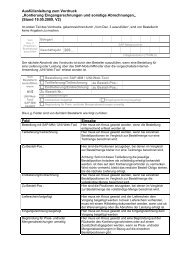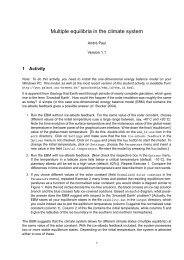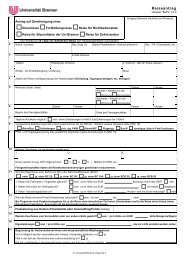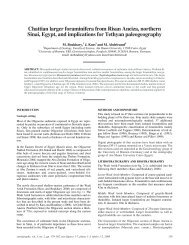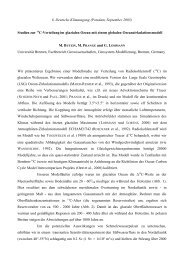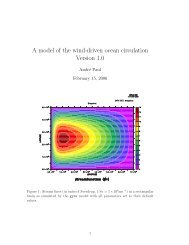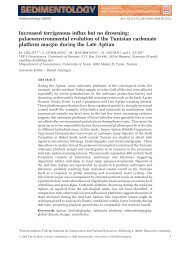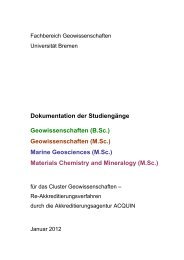Forschung im HLRN-Verbund 2011
Forschung im HLRN-Verbund 2011
Forschung im HLRN-Verbund 2011
- Keine Tags gefunden...
Sie wollen auch ein ePaper? Erhöhen Sie die Reichweite Ihrer Titel.
YUMPU macht aus Druck-PDFs automatisch weboptimierte ePaper, die Google liebt.
154Tail plane aerodynamics of aircraftNumerical Investigation of Interference Effects of the Horizontal and the VerticalTail Planes on Transport AircraftR. Radespiel, V. Nallapula, Institut fürStrömungsmechanik, Technische UniversitätBraunschweigAbstract• The project a<strong>im</strong>s at assessing the influence ofthe interference effects caused by the horizontaltail plane (HTP) and the vertical tail plane (VTP)on the aerodynamic performance of the completeaircraft.• An <strong>im</strong>portant a<strong>im</strong> of this project is to predictthe max<strong>im</strong>um lift coefficient, C lmax and its correspondingangle of attack, α.• A further a<strong>im</strong> is to identify the effects caused bythe tail plane on the flight performance of an aircraftduring stall manoeuvres.The present project is a sub-project of HINVA (HighLift In Flight Investigation), which a<strong>im</strong>s at predictingthe max<strong>im</strong>um lift of an aircraft configuration(C lmax ) in design phase. The HINVA project isled by the Deutsche Zentrum für Luft und Raumfahrt(DLR). The project follows a strategy, which isbased on comparing numerically s<strong>im</strong>ulated resultswith that of exper<strong>im</strong>ents performed in the Europeantransonic wind tunnel (ETW) and finally evaluatingthe predicted flight performances with flight tests.Hence, new validation data bases are generatedthat lead to new numerical design capabilities.The max<strong>im</strong>um lift performance of an aircraft isdetected by performing stall manoeuvres duringflight testing, the obtained max<strong>im</strong>um lift coefficientis one of the most <strong>im</strong>portant parameters for thelanding configuration of an aircraft. The presentproject concentrates on analyzing the interferenceeffects caused by the tail plane on the flight performanceof the aircraft and in particular on the influenceof the HTP on the max<strong>im</strong>um lift coefficientduring stall with the help of numerical s<strong>im</strong>ulations.In order to study the HTP and its influence, a comprehensiveunderstanding of the flight physics ofthe tail plane is required which is obtained by performingvarious sensitivity analyses. The sensitivityanalyses include changing of the angle of incidenceof the HTP (i H ), angle of attack (α), influenceof various turbulence models and also studiesof the downwash of the wing.In order to proceed with the aforementionedtasks an efficient numerical s<strong>im</strong>ulation strategy is<strong>im</strong>portant. This can be achieved by the state ofthe art numerical flow solver DLR-TAU code [1],[2].In aerodynamics the lift coefficient increases withincreasing angle of attack. The critical angle of attackbeyond which the lift coefficient decreases issaid to be the stalling point of an aircraft (this isdepicted in the top of figure 1).The numerical approach for this study involvescomputing the half model of the complete aircraft,symmetrically split along the axis of the fuselage.The numerical grid for this setup is generated usingthe commercial grid generator Centaur [3]. Ahybrid unstructured grid is generated for the geometrywith either prismatic/hexahedral elementsin the boundary layer (region of high solution gradients)coupled with unstructured tetrahedral elementsaway from the boundary layer. Turbulenttransport in the boundary layers is taken into accountin the so called eddy viscosity models [4] andadvanced Reynolds Stress Models [6]. To this end,3-D flow s<strong>im</strong>ulations are envisaged for the geometryat a Mach number, Ma = 0.2 with a Reynoldsnumber of 15 × 10 6 at high angles of attack (at aircraftstall). In aerodynamics, Mach number (Ma) isdefined as the ratio of the flight speed to that of thespeed of sound, Reynolds number (Re) is definedas the ratio of inertial forces to viscous forces. Replays an <strong>im</strong>portant role in characterising the flowreg<strong>im</strong>e as well as providing the basis for aerodynamics<strong>im</strong>ilitude of models.Figure 1 (top) shows the computed variation ofcoefficient of lift with that of the angle of attack. Itcan be seen that the lift coefficient increases linearlywith increase in angle of attack until a criticalangle is reached. At this critical angle of attack(α c ), the value of the lift coeffecient is said to beat its max<strong>im</strong>um (C lmax ). A s<strong>im</strong>ilar phenomenon isobserved with the drag coefficient (C d ) where afterthe (α c ) a rapid increase in the drag coefficient canbe observed from figure 1 (top).Figure 1 (bottom) shows the pressure coefficientwith stream traces based on skin-friction representedby black lines depicting the path of the fluidmolecules close to the wall. Low pressure regionscan be observed over the wing which are responsiblefor providing the lift required to overcome theweight of an aircraft. It appears that meaningfuls<strong>im</strong>ulations of the flow over the aircraft make theresolution of a great variety of flow scales neccessaryand this justifies the usage of the <strong>HLRN</strong> supercomputerfor this project.Ingenieurwissenschaften



